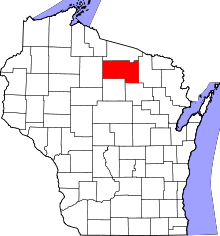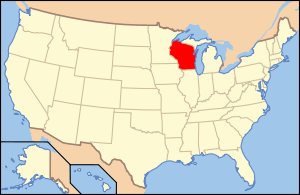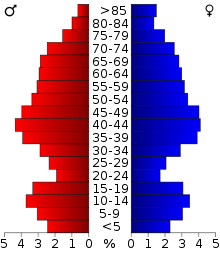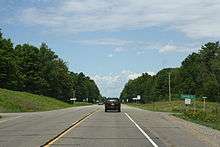Oneida County, Wisconsin
| Oneida County, Wisconsin | |
|---|---|
 Oneida County Courthouse in Rhinelander | |
 Location in the U.S. state of Wisconsin | |
 Wisconsin's location in the U.S. | |
| Founded | 1887 |
| Named for | Oneida people |
| Seat | Rhinelander |
| Largest city | Rhinelander |
| Area | |
| • Total | 1,236 sq mi (3,201 km2) |
| • Land | 1,113 sq mi (2,883 km2) |
| • Water | 123 sq mi (319 km2), 10% |
| Population | |
| • (2010) | 35,998 |
| • Density | 32/sq mi (12/km²) |
| Congressional district | 7th |
| Time zone | Central: UTC-6/-5 |
| Website |
www |
Oneida County is a county in the state of Wisconsin, United States. At the 2010 census, the population was 35,998.[1] Its county seat is Rhinelander.[2]
History
Oneida County was formed in 1887 from sections of Lincoln County.[3] It was named after the indigenous Oneida tribe, one of the five nations of the Iroquois.
Geography
According to the U.S. Census Bureau, the county has a total area of 1,236 square miles (3,200 km2), of which 1,113 square miles (2,880 km2) is land and 123 square miles (320 km2) (10%) is water.[4] Most people visit Oneida County to enjoy its lakes. In particular, tourists flock to Minocqua, a town of nearly 5,000 people with a summer population around 15,000.
Adjacent counties
- Forest County - east
- Langlade County - southeast
- Lincoln County - south
- Price County - west
- Vilas County - north
Major highways
 U.S. Highway 8
U.S. Highway 8 U.S. Highway 45
U.S. Highway 45 U.S. Highway 51
U.S. Highway 51 Highway 17 (Wisconsin)
Highway 17 (Wisconsin) Highway 32 (Wisconsin)
Highway 32 (Wisconsin) Highway 47 (Wisconsin)
Highway 47 (Wisconsin) Highway 70 (Wisconsin)
Highway 70 (Wisconsin)
Airport
The Rhinelander-Oneida County Airport (KRHI) serves the county and surrounding communities with both scheduled commercial jet service and general aviation services. Located two miles southwest of Rhinelander, the airport handles approximately 24,860 operations per year, with approximately 88% general aviation, 6% scheduled commercial air service and 6% air taxi. The airport has a 6,799-ft. concrete runway with approved ILS, GPS and VOR/DME approaches (Runway 9-27) and a 5,201-ft. asphalt crosswind runway with approved GPS approaches (Runway 15-33). In addition, the Rhinelander VORTAC (RHI) navigational facility is located at the field. [5]
National protected area
- Nicolet National Forest (part)
Demographics

| Historical population | |||
|---|---|---|---|
| Census | Pop. | %± | |
| 1890 | 5,010 | — | |
| 1900 | 8,875 | 77.1% | |
| 1910 | 11,433 | 28.8% | |
| 1920 | 13,996 | 22.4% | |
| 1930 | 15,899 | 13.6% | |
| 1940 | 18,938 | 19.1% | |
| 1950 | 20,648 | 9.0% | |
| 1960 | 22,112 | 7.1% | |
| 1970 | 24,427 | 10.5% | |
| 1980 | 31,216 | 27.8% | |
| 1990 | 31,679 | 1.5% | |
| 2000 | 36,776 | 16.1% | |
| 2010 | 35,998 | −2.1% | |
| Est. 2015 | 35,567 | [6] | −1.2% |
| U.S. Decennial Census[7] 1790–1960[8] 1900–1990[9] 1990–2000[10] 2010–2014[1] | |||
At the census[11] of 2000, there were 36,776 people, 15,333 households, and 10,487 families residing in the county. The population density was 33 people per square mile (13/km²). There were 26,627 housing units at an average density of 24 per square mile (9/km²). The racial makeup of the county was 97.71% White, 0.33% Black or African American, 0.66% Native American, 0.30% Asian, 0.05% Pacific Islander, 0.21% from other races, and 0.75% from two or more races. 0.66% of the population were Hispanic or Latino of any race. 44.4% were of German, 8.8% Polish, 7.9% Irish, 5.2% Norwegian and 5.2% English ancestry according to Census 2000.
There were 15,333 households out of which 27.00% had children under the age of 18 living with them, 57.80% were married couples living together, 7.10% had a female householder with no husband present, and 31.60% were non-families. 26.40% of all households were made up of individuals and 12.00% had someone living alone who was 65 years of age or older. The average household size was 2.34 and the average family size was 2.82.
In the county, the population was spread out with 22.30% under the age of 18, 5.70% from 18 to 24, 26.50% from 25 to 44, 26.80% from 45 to 64, and 18.70% who were 65 years of age or older. The median age was 42 years. For every 100 females there were 99.20 males. For every 100 females age 18 and over, there were 97.30 males.
Communities

City
- Rhinelander (county seat)
Towns
Census-designated places
Unincorporated communities
Ghost towns
See also
References
- 1 2 "State & County QuickFacts". United States Census Bureau. Retrieved January 22, 2014.
- ↑ "Find a County". National Association of Counties. Retrieved 2011-06-07.
- ↑ "Wisconsin: Individual County Chronologies". Wisconsin Atlas of Historical County Boundaries. The Newberry Library. 2007. Retrieved August 15, 2015.
- ↑ "2010 Census Gazetteer Files". United States Census Bureau. August 22, 2012. Retrieved August 6, 2015.
- ↑ http://www.airnav.com/airports/rhi
- ↑ "County Totals Dataset: Population, Population Change and Estimated Components of Population Change: April 1, 2010 to July 1, 2015". Retrieved July 2, 2016.
- ↑ "U.S. Decennial Census". United States Census Bureau. Retrieved August 6, 2015.
- ↑ "Historical Census Browser". University of Virginia Library. Retrieved August 6, 2015.
- ↑ Forstall, Richard L., ed. (March 27, 1995). "Population of Counties by Decennial Census: 1900 to 1990". United States Census Bureau. Retrieved August 6, 2015.
- ↑ "Census 2000 PHC-T-4. Ranking Tables for Counties: 1990 and 2000" (PDF). United States Census Bureau. April 2, 2001. Retrieved August 6, 2015.
- ↑ "American FactFinder". United States Census Bureau. Retrieved 2011-05-14.
Further reading
- Jones, George O. and Norman S. McVean (comp.) History of Lincoln, Oneida and Vilas Counties, Wisconsin. Minneapolis: H. C. Cooper, Jr., 1924.
 |
Vilas County |  | ||
| Price County | |
Forest County | ||
| ||||
| | ||||
| Lincoln County | Langlade County |
External links
- Oneida County website
- Oneida County map from the Wisconsin Department of Transportation
Coordinates: 45°42′N 89°31′W / 45.70°N 89.52°W
